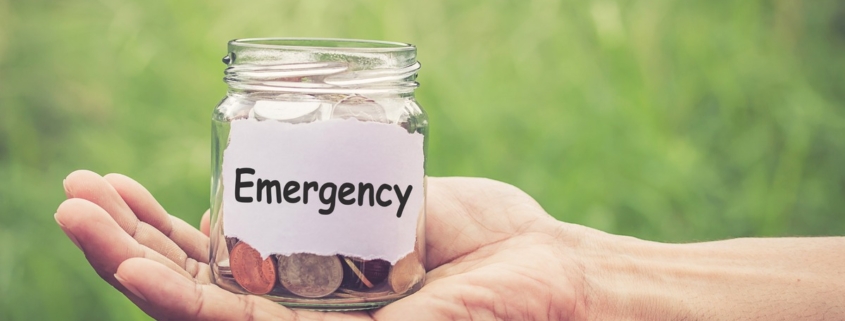Prepare for a Financial Emergency with These 4 Tips
January 04, 2022
The thought of being hit with a major negative event that could affect your finances, such as a job loss, an illness, or a pandemic, can keep anyone awake at night. Emergencies won’t wait until you’re financially ready, so prepare for them now.
Noone likes or wants them – but life emergencies happen. In these stressful times, having access to personal financial, insurance, medical and other records is crucial for starting the recovery process quickly and efficiently.
The best time to prepare for a financial emergency is by preparing well in advance. If you wait until something unfortunate happens, you could find yourself scrambling to be able to find the needed funds. Here are 4 tips to help you prepare for a financial emergency.
Create A Budget
This is by far the most overlooked part in financial planning. While budgeting can be tedious, you’ll have a picture of your income and expenses and you’ll be better equipped to build a bigger savings cushion. To get started, you’ll need to track your expenses. Use an online budgeting tool or app that links to your bank, investment, credit card and other accounts and automatically tracks and categorizes expenses.
A simple budget breakdown follows the 50-20-30 rule: Up to 50% of your take-home pay is for essential expenses, such as rent or mortgage payments, utility bills, transportation to work, groceries, and insurance premiums; at least 20% goes toward saving for retirement, an emergency fund and other goals, and paying down debt; and up to 30% is designated for nonessentials, which may include restaurant meals and travel and entertainment spending.
Our free online financial calculators are a great first step. Financial calculators are a helpful tool to assist you in managing your money and estimating your loan payments. All you need is some information about your finances and these specialized online math machines will spit out the numbers or percents you need to manage your finances and make budgeting decisions. Try out our fast, easy and free online resources here.
Have More Rainy Day Funds in Place
Without savings, a financial shock—even minor—could set you back, and if it turns into debt, it can potentially have a lasting impact.
Setting up a dedicated savings or emergency fund is one essential way to protect yourself, and it’s one of the first steps you can take to start saving. Instead of maintaining one fund for large, unexpected expenses, why not create two? Your true emergency fund is meant for catastrophes that may result in a total loss of income, such as divorce, job loss, or medical or mental disability that keeps you out of work. Set aside “rainy day” funds for urgent but less-catastrophic needs, such as car and home repairs, medical and vet bills, and short-notice travel to be with an ill relative.
How much should you put in each? For the rainy-day fund, financial advisors recommend setting aside about $1,500 for young, single renters and between $3,000 and $5,000 for homeowners, depending on how much upkeep your home needs. Your secondary emergency fund, you should have enough to cover at least six months of expenses. If starting small, try to set aside at least $500, but work your way up to half a year’s worth of expenses.
Paying Down Debt
Now that you have your rainy day fund set aside, you can start paying down some of your debt. People often find that a lot of their budget goes to paying off debt, which can make it even harder to devote money to emergency savings. There are a number of different options for paying off debt that may make sense for your situation.
Whether your current debt is your car payment or a credit card bill, it’s always a good idea to pay a little more than the minimum. You’ll save the most by paying off debts in order of highest to lowest interest rate. But eliminating the debt with the smallest balance first—even if it doesn’t carry the highest rate—may give you the momentum you need to stick with the plan.
If you feel overwhelmed by debt or your efforts to pay off debt are not making progress, a money management plan could be a helpful tool to lower your interest, save money and pay off debt faster.
Re-Allocate Your Assets
Financial advisors suggest young people who have time to withstand market changes should invest their nest egg in stocks and people closer to retirement age should ramp up their holdings in bonds and cash. This offers lower potential returns than stocks – but less volatility.
The asset allocation that’s right for you depends on your capacity and tolerance for risk. The former gauges how a downturn might impact your lifestyle or derail your goals. The latter is how much of a loss you could stand before you abandon your plan. Rebalance your holdings periodically to make sure they’re in line with your target mix.
Furthermore, you may already have some amount of assets that could be channelized to your emergency fund. It could be extra cash lying around in your savings accounts, some fixed deposits that are not linked to any particular goal, among others. You can allocate some of that amount towards your emergency fund.
Final Thoughts
When the unexpected happens, it’s downright debilitating to your long-term financial health. A financial emergency plan is an exceptionally valuable tool for an unexpected situation that often happens in life.
Finding the right Fiduciary that fits your goals and lifestyle doesn’t have to be hard. The trusted team at Agemy Financial Strategies is here for your every step of the way to make some real progress on your journey to financial freedom this coming year.
For more information on money management and financial emergency planning, talk to one of our financial advisors here today.







Leave a Reply
Want to join the discussion?Feel free to contribute!